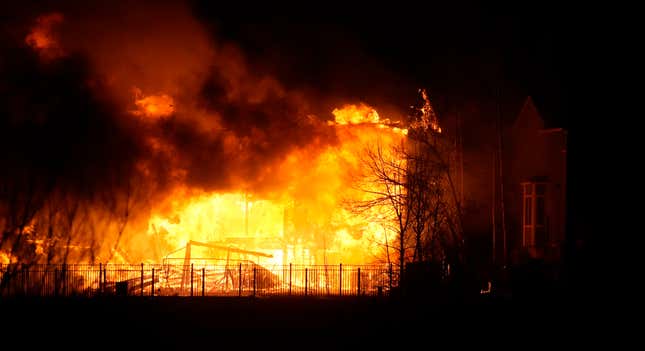
A series of unprecedented December wildfires coupled with raging winds of more than 105 mph (169 kmh) forced the evacuation of thousands in northern Colorado on Thursday. It’s the latest freak weather calamity to unleash chaos in a bizarre December of chock full of them, one that has taken an unimaginable toll.
At least 580 homes have been destroyed as twin fires roar through Boulder County, located just to the north of Denver. That would beat the ignominious record set by the 2013 Black Forest Fire that burned 498 structures.
Authorities with the Boulder Office of Emergency Management told about 13,000 residents in the town of Superior and 21,000 in the town of Louisville to evacuate on Thursday afternoon due to the deadly threat posed by the Middle Fork Fire and the Marshall Fire. Colorado Gov. Jared Polis’ office said the grass fires were created by high winds across the Front Range, which has had a dry and mild fall and winter, and said the governor had declared a state of emergency. According to the Associated Press, downed power lines may have ignited some of fires in what is an increasingly common occurrence across the West. (Just not normally in December.)
“Boulder OEM is getting many calls about residents seeing fire. IF YOU SEE FIRE, EVACUATE. Go east, go north, but leave immediately,” Boulder OEM wrote on its website at noon local time.
Nonetheless, this doesn’t mean that residents should wait to evacuate until they see flames, the National Weather Service in Boulder pointed out, urging those in affected areas to get out immediately. Indeed, videos showed flames moving with speed and ferocity normally associated with the peak fire season in the middle of summer, not the dead of winter.
Boulder OEM added in a later alert that some residents had lost power and couldn’t evacuate because they couldn’t get their cars out of the garage, which sounds like a highly stressful problem to have in such a dangerous situation.

“All garages have a red handle INSIDE that allows you to manually open your garage. Pull the handle to open your garage door,” Boulder OEM said.
A video from a local KMGH-TV reporter near a Home Depot in Louisville looked like a scene from another world. Smoke covered the area like a thick blanket while the wind growled and shook trees. Other footage shows numerous structures burned to the ground as winds rush through the trees. While these scenes have become commonplace in summer as the climate crisis primes the West to burn, the intensity and location of these fires burning at what’s known as the wildland-urban interface in December is deeply unsettling in a whole new way.
“Prayers for thousands of families evacuating from the fires in Superior and Boulder County. Fast winds are spreading flames quickly and all aircraft are grounded,” Gov. Polis said on Twitter.
The wildfires join a parade of dangerous weather events that have marauded across the U.S. this December. Among them are freak heat in the eastern third of the country while the Northern Rockies went into a deep freeze; unprecedented heat for any winter month in Alaska; monster snowstorms in California; deadly tornadoes in the South; and a wind and dust storm trailed by a derecho.
The cause for so much wild weather is a jet stream that has taken bizarre twists and turns, allowing cold air to drop from the Arctic and warm air to rush up from the tropics in weird places. The split in temperature gradient has helped fuel some of the strange weather. Climate change is, of course, also upping the odds of wildfires since a little extra heat allows fires to spread more rapidly.
This is also Colorado’s second weird fire outbreak in as many months. In mid-November, wildfires sprung up in the mountains near the gateway to Rocky Mountain National Park, a place normally accustomed to snow rather than flames at this time of year. The state is completely consumed by drought, with the areas where the fires are burning is in extreme drought, the second-worst ranking in the Drought Monitor. The West itself is in the midst of a megadrought unseen in 1,200 years that has sapped soil moisture and cut into reservoirs. And now, it appears, it’s helped fuel fires in December.
Updated, 12/30/21, 11:07 p.m.: This post has been updated with new information, including the extent of the damage cataloged so far.